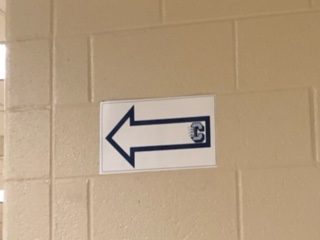Yea or Nay: Students and Faculty Weigh in on the Hallway Arrows

Blue arrows guide students’ paths throughout the halls.
December 11, 2020
Figuring out the easiest way between classes might seem simple and mundane, but having your path blocked and being forced to go another, longer way isn’t either of those things.
Over the summer, a group of teachers, administration, and community members devised a plan to reduce possible COVID-19 exposures for when students came back to the building. The result was the hallway arrows, which direct students in a one-way direction in most hallways.
Assistant Principal David Goldie was a member of the group that developed the idea of the arrows and has been very involved with their implementation since the beginning.
He said the reasoning behind the arrows was to have students move more like how elementary schoolers move between classes. Elementary school students stay with the same group of classmates the entire day, which constitutes their “bubble.”
“The idea of the one-way system is to have that one group of students in their bubble around the building so to not cross with other students to risk exposure,” Goldie said.
One student moving normally between their classes would be “crossing paths with almost 2,000 students throughout the day,” which would greatly increase the possibility for exposure, hence the reason for the arrows.
While the arrows are necessary for preventing COVID-19 cases, they have proven an impediment to students’ transitions between classes.
Some students said they accepted the hindrance, understanding it is for their own good, while others fight for their preferred path in the name of speed.
At the beginning of the school year, science teacher Gretchen Martin, an enforcer of the hallway arrows, could often be seen standing sentry by her classroom. Good luck to the student who tried to get past her watchful eye.
Martin is one of many teachers who engaged in a constant battle with students who feel that convenience overrules safety. The student population is divided on the issue of whether the arrows in the hallways – used to help with social distancing – are a good idea or a bad one and whether it’s important to follow them.
Martin’s classroom is positioned in the English hall, a prime spot for arrow–induced trouble. This area has been troubling for students because the arrows have often turned what would have been a short walk to class into a hike around the school.
Students have learned how to adjust their routes in order to comply with the arrows. At first, though, students would ignore the arrows and try to go the wrong way in the halls, Martin said.
“It’s kind of funny to see them turn the corner and go on whereas before they would turn and try.”
“It’s like a ballet,” Martin said.
She said she thinks it’s important to follow the arrows so that students are social distancing as much as possible.
“We’re preventing the spread. As many ways as we can do that, the better,” she said.
Martin also said she is pleased that the teachers and administration have eased up on their enforcement of the arrows. She said students should simply “be aware of whether someone is coming towards you” and make good decisions about following the arrows that keep yourself and others safe.
Martin said students are doing a pretty good job following the arrows.
“Each phase was a new learning curve. After a day, kids were following them right,” she said.
Ultimately, Martin thinks the arrows were a great idea.
“I’m grateful that we got to implement them and grateful that we’ve relaxed about it too,” she said.
Senior Becca Brown, on the other hand, is not a fan of the hallway arrows. They have been a source of frustration for her since the start of school.
“Everyone is so used to going their certain way to get to class and now there are the arrows,” she said. “There are hundreds of loops to get to a class right around the corner. It’s a hassle.”
She said the arrows on the second floor are a lot more inconvenient than the ones on the first floor.
Another trouble has been that she “can’t seem to figure out which stairwells go down and which stairwells go up,” sometimes causing her to be late to class, she said.
A further annoyance for her is that some students don’t follow the arrows, making the directions even more confusing.
“I see a lot of people coming from the opposite direction, and I think I’m going the wrong direction,” she said.
Even though Brown says the arrows “mess up her entire schedule,” she understands why they’re in place and thinks it’s important to follow them.
“Going in the same direction makes it less likely that you’ll be facing someone,” she said. “I feel like you’re less likely to get Corona if you’re not breathing face-to-face or bumping into someone going the opposite direction.”
On the bright side, Brown has found that the arrows have cut down on traffic jams since there are not as many people in the halls.
Freshman Annie Ritter doesn’t see the arrows as nearly as much of an issue.
“They’re kind of annoying, but they give us ten minutes in between classes,” she said.
Ritter takes the same routes to classes every day, so once she figured out her path, the arrows weren’t a nuisance.
The only trouble the arrows have caused for her thus far are the one-way staircases.
“You have to walk a little farther to get to the right stairway,” she said.
Ritter thinks that students have gotten better at following the arrows since the first day of school, but now they “don’t really care about the arrows anymore,” she said.
Ritter doesn’t see this as a pressing issue though. She doesn’t think following the arrows is very important because she doesn’t think it does much to cut down on possible COVID-19 exposure.
“Not everyone follows [the arrows] anyway and everyone’s wearing masks,” she said.
Goldie is aware of this problem. To address it, he compared the hallway arrows to driving. Even if a parking spot (or a classroom) is right there, the driver (or the student) still must obey the flow of traffic.
He said the administration are very appreciative of the students that are following the arrows. He thinks the main reason for this cooperation is that “students understand it’s about protecting themselves and others.”
Goldie said they do not know how much longer the arrows will be in effect, since no one knows when the pandemic will be over.
“I suspect we will continue to be cautious and put safety first,” he said.
